Das
Book
Offensive
and Defensive Formations

Offensive
Formations
There are many possible formations that fall within legal guidelines.
I use 12. Twelve is plenty for my offensive scheme because each formation
can be modified by sending one of several players in motion, or simply
slightly shifting one or more players. Also many formations can be
run from the shotgun, or not. For these reasons explicit, detailed,
single diagrams for each formation serve little purpose. Instead
let's look at all of them at once, and then briefly discuss each.
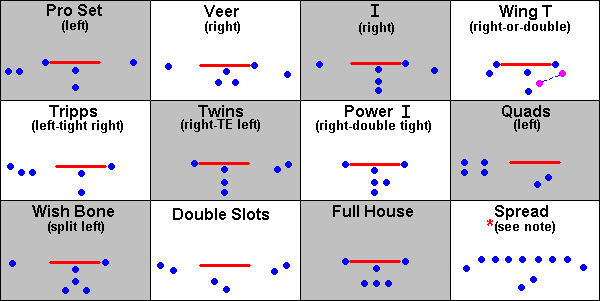 The basic Pro Set (shown here as Pro Left) calls for the TE left
with both flankers. The opposite WR is split to the right.
The QB is under center, with one running back. This formation is
extremely popular because there are five eligible receivers, the inside
flanker or the running back can go in motion, or the formation can employ
the shot gun. This formation is equally effective for the run or
the pass. The Veer and the "I" are equally popular
for the same reasons, but employ two running backs. This strengthens
the running game by adding an additional running back to the overall scheme.
The Power "I", Full House, Wing-T, and the Wishbone
(optional) all can utilize two tight ends and three running backs making
them strong running formations while still keeping 5 receivers eligible
for the pass. The Twins set calls for two receivers to the
same side with the tight end to the opposite side, in tight or split wide.
Two backs are in the backfield, both eligible to be set in motion. Tripps
simply calls for one of the backs to join the wide receivers forming a
trio of wide outs to the same side. Again, the tight end (to the
opposite side) can be optionally split wide. Quads call for
four receivers to the same side, two up on the line with the other two
stacked behind them. The back two receivers can be offset from the
forward two. Slots call for two receivers to each side with
the outer two up on the line of scrimmage, the inner two a step back.
The Spread formation lives up to its name. Each lineman increases
his splits from one to three (4, or 5) yards. There are two tight
ends, two flankers out wide, five linemen, a back and a quarterback.
There are eight lanes between the nine forward players. If their
respective gaps are 5 yards apart, you "spread" the offense out over 40
yards. If the defense responds by splitting out wide with the offense,
the quarterback can hand off to the back who has widened running lanes.
If the defense does not spread out with the offense, there should be mismatches
to the wide sides of the field for the pass. Each of the formations
can have a variety of looks to the defense. For instance, every formation
has a 'mirror' side. Tripps right can be run as Tripps left.
All twelve formations can send a player in motion. Eight of the twelve
formations can utilize the shot gun formation where the quarterback lines
up 5 to 7 yards deep in the back field as opposed to taking the snap from
under center. Also, many of the formations can take on an entirely
different look simply by shifting one or more players around. An
excellent example of this is the Wing-T formation. The Wing-T can
be run as Wing-T left with the back to the right (1), left with the back
to the left (2), left with the back in motion (3), left with the Wing Man
(purple dot in the diagram) in motion (4), these options 'mirror' plays
(5,6,7,8), with or without the shot gun (9,10), or from the Double Wing-T
with or without the shot gun (11,12). So, in fact, the Wing-T formation
(one of twelve) can have twelve different, distinct looks for the defense.
Multiply these results by the total number of possible plays which can
be run from most of the formations and one can begin to sense the vast
number of "looks" the offense can give a defense. Add an intentionally
diverse, tricky snap count and the offense should be able to keep the defense
on its heels further expanding the play calling options for the coaching
staff.
The basic Pro Set (shown here as Pro Left) calls for the TE left
with both flankers. The opposite WR is split to the right.
The QB is under center, with one running back. This formation is
extremely popular because there are five eligible receivers, the inside
flanker or the running back can go in motion, or the formation can employ
the shot gun. This formation is equally effective for the run or
the pass. The Veer and the "I" are equally popular
for the same reasons, but employ two running backs. This strengthens
the running game by adding an additional running back to the overall scheme.
The Power "I", Full House, Wing-T, and the Wishbone
(optional) all can utilize two tight ends and three running backs making
them strong running formations while still keeping 5 receivers eligible
for the pass. The Twins set calls for two receivers to the
same side with the tight end to the opposite side, in tight or split wide.
Two backs are in the backfield, both eligible to be set in motion. Tripps
simply calls for one of the backs to join the wide receivers forming a
trio of wide outs to the same side. Again, the tight end (to the
opposite side) can be optionally split wide. Quads call for
four receivers to the same side, two up on the line with the other two
stacked behind them. The back two receivers can be offset from the
forward two. Slots call for two receivers to each side with
the outer two up on the line of scrimmage, the inner two a step back.
The Spread formation lives up to its name. Each lineman increases
his splits from one to three (4, or 5) yards. There are two tight
ends, two flankers out wide, five linemen, a back and a quarterback.
There are eight lanes between the nine forward players. If their
respective gaps are 5 yards apart, you "spread" the offense out over 40
yards. If the defense responds by splitting out wide with the offense,
the quarterback can hand off to the back who has widened running lanes.
If the defense does not spread out with the offense, there should be mismatches
to the wide sides of the field for the pass. Each of the formations
can have a variety of looks to the defense. For instance, every formation
has a 'mirror' side. Tripps right can be run as Tripps left.
All twelve formations can send a player in motion. Eight of the twelve
formations can utilize the shot gun formation where the quarterback lines
up 5 to 7 yards deep in the back field as opposed to taking the snap from
under center. Also, many of the formations can take on an entirely
different look simply by shifting one or more players around. An
excellent example of this is the Wing-T formation. The Wing-T can
be run as Wing-T left with the back to the right (1), left with the back
to the left (2), left with the back in motion (3), left with the Wing Man
(purple dot in the diagram) in motion (4), these options 'mirror' plays
(5,6,7,8), with or without the shot gun (9,10), or from the Double Wing-T
with or without the shot gun (11,12). So, in fact, the Wing-T formation
(one of twelve) can have twelve different, distinct looks for the defense.
Multiply these results by the total number of possible plays which can
be run from most of the formations and one can begin to sense the vast
number of "looks" the offense can give a defense. Add an intentionally
diverse, tricky snap count and the offense should be able to keep the defense
on its heels further expanding the play calling options for the coaching
staff.
Defensive
Formations
.
The 5-2 Defensive Formation
The 5-2 is the standard for many coaches at the
high school level and is used somewhat extensively at the collegiate level.
Consisting of a nose guard, 2 defensive tackles, and 2 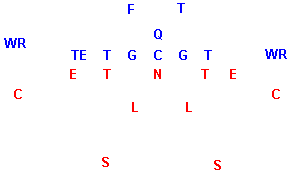 defensive
ends, it is intended mainly as a run defense. However, it can be
effective against the pass as well with five pass rushers and two or three
linebackers. Usually, the down linemen's first responsibilities are
running lane specific, each man responsible for a certain gap or lane.
The default command for linemen is to read and react to the play, with
the defensive end's primary concern being containment. Occasionally,
a defensive end may be called on to pass defend an area such as the flat.
By design, the line backer's first responsibility is to defend the run,
then the pass. But this may be modified for varying purposes.
A coach wants his leading tacklers to be down linemen or line backers.
If a defensive back or safety is leading the team in tackles, it is a clear
indication that the opposing offenses are getting throughout the first
line of defense. The remaining four positions are the two corner
backs and the two safeties. An option is to allow one of the safeties
to be a "free safety" meaning that this player seldom has specific duties,
and is left to read and react to each play. If in zone pass coverage,
the free safety or safety to the TE side has "up" responsibility, while
the strong safety has deep third duty. Each corner has deep third
duty as well. LBs are 4 to 5 yards off the ball, CBs 3 to 6 yards
deep, safeties 10 to 12 yards. Down linemen keep the ball in the
corner of the eye, and move on the snap--not the QB's vocalizations or
other personnel movement.
defensive
ends, it is intended mainly as a run defense. However, it can be
effective against the pass as well with five pass rushers and two or three
linebackers. Usually, the down linemen's first responsibilities are
running lane specific, each man responsible for a certain gap or lane.
The default command for linemen is to read and react to the play, with
the defensive end's primary concern being containment. Occasionally,
a defensive end may be called on to pass defend an area such as the flat.
By design, the line backer's first responsibility is to defend the run,
then the pass. But this may be modified for varying purposes.
A coach wants his leading tacklers to be down linemen or line backers.
If a defensive back or safety is leading the team in tackles, it is a clear
indication that the opposing offenses are getting throughout the first
line of defense. The remaining four positions are the two corner
backs and the two safeties. An option is to allow one of the safeties
to be a "free safety" meaning that this player seldom has specific duties,
and is left to read and react to each play. If in zone pass coverage,
the free safety or safety to the TE side has "up" responsibility, while
the strong safety has deep third duty. Each corner has deep third
duty as well. LBs are 4 to 5 yards off the ball, CBs 3 to 6 yards
deep, safeties 10 to 12 yards. Down linemen keep the ball in the
corner of the eye, and move on the snap--not the QB's vocalizations or
other personnel movement.
The 5-3 Defensive Formation
The 5-3 is even more intent on stopping the run
and is designed to make use of a strong middle line backer. Similar
to the 5-2, 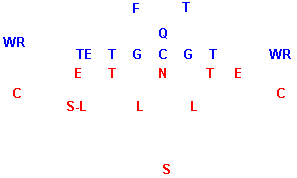 the
5-3 simply replaces the free safety spot with a third line backer which
lines up on the outside shoulder of the TE, 5 yards deep and parallel with
the other LBs. The "best" LB move to the middles LB position.
Obviously, modifications, or shifts, may be necessary depending on the
actual alignment of the offense. For example, let's say the offense
opened in a Tripps (3 receiver) set to the defense's right. basically,
all that has happened is the FB and left wide out have been replaced with
two new wide outs to the right. So the left CB shifts over with the
new WR, and the left OLB shifts over as well. The two remaining linebackers
return to their normal 5-2 alignment. Another variation calls for
the 3 line backers to all shift down to compensate. The TE can be
covered by the DE to that side, or the LB to that side. The DE to
the Tripps side can cover the flat or slat area, or even be sent on a blitz.
the
5-3 simply replaces the free safety spot with a third line backer which
lines up on the outside shoulder of the TE, 5 yards deep and parallel with
the other LBs. The "best" LB move to the middles LB position.
Obviously, modifications, or shifts, may be necessary depending on the
actual alignment of the offense. For example, let's say the offense
opened in a Tripps (3 receiver) set to the defense's right. basically,
all that has happened is the FB and left wide out have been replaced with
two new wide outs to the right. So the left CB shifts over with the
new WR, and the left OLB shifts over as well. The two remaining linebackers
return to their normal 5-2 alignment. Another variation calls for
the 3 line backers to all shift down to compensate. The TE can be
covered by the DE to that side, or the LB to that side. The DE to
the Tripps side can cover the flat or slat area, or even be sent on a blitz.
The 4-4 Defensive Formation
The 4-4 is designed to stop the wide running game
as well as the short passing game. 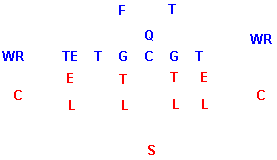 The 4-4 uses four down linemen, four linebackers, two cornerbacks, and
a safety. Stunts are a common component of this defensive set, usually
with the some or all of the linemen stunting left or right and the inside
linebackers stunting in the opposite direction. A wide range of possible
stunts and blitzes are possible. The 4-4, also known as the "Stack"
defense, relies on quickness, particularly quickness in pursuit.
In order to run the 4-4 on a regular basis, the interior down linemen must
be players of considerable substance.
The 4-4 uses four down linemen, four linebackers, two cornerbacks, and
a safety. Stunts are a common component of this defensive set, usually
with the some or all of the linemen stunting left or right and the inside
linebackers stunting in the opposite direction. A wide range of possible
stunts and blitzes are possible. The 4-4, also known as the "Stack"
defense, relies on quickness, particularly quickness in pursuit.
In order to run the 4-4 on a regular basis, the interior down linemen must
be players of considerable substance.
The 4-3 Defensive Formation
The 4-3 is the most commonly used defense at the
upper levels, including the NFL. At lower levels the 4-3 is not particularly
popular because many coaches consider it weak against the run due to the
fact there are only four down linemen. At the higher levels, the
quality and size of the average down linemen makes this a non factor.
In essence, if a team possesses the size, strength, 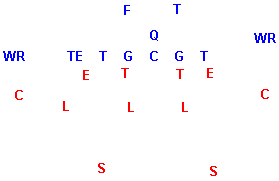 and
quickness necessary to run the 4-3 defense, it is a formidable defensive
formation. Besides the ever present four down linemen (2 DTs and
2 DEs), there are three line backers--two to the inside and one at the
outside shoulder of the TE. Two cornerbacks and two safeties are
the standard. Equally effective against most all offensive formations,
the 4-3 is the default defense of choice for this author. It is easily
modified for various offensive sets. The third LB (on the TE) can cover
the TE, blitz, or cover any of the short zones to that side or the hook
zone over the middle. The CBs can blitz with the Safety(s) assuming
the Corner's responsibilities. Or a Corner can drop back in deep
coverage allowing a safety blitz. Because of its high flexibility,
an offense will find it difficult to isolate a particular area or defensive
player. If the 4-3 has a weakness, it is that the inside line backers
are the primary tacklers for runs between the tackles and they are of course
4 to 5 yards off the ball.
and
quickness necessary to run the 4-3 defense, it is a formidable defensive
formation. Besides the ever present four down linemen (2 DTs and
2 DEs), there are three line backers--two to the inside and one at the
outside shoulder of the TE. Two cornerbacks and two safeties are
the standard. Equally effective against most all offensive formations,
the 4-3 is the default defense of choice for this author. It is easily
modified for various offensive sets. The third LB (on the TE) can cover
the TE, blitz, or cover any of the short zones to that side or the hook
zone over the middle. The CBs can blitz with the Safety(s) assuming
the Corner's responsibilities. Or a Corner can drop back in deep
coverage allowing a safety blitz. Because of its high flexibility,
an offense will find it difficult to isolate a particular area or defensive
player. If the 4-3 has a weakness, it is that the inside line backers
are the primary tacklers for runs between the tackles and they are of course
4 to 5 yards off the ball.
The 3-4 Defensive Formation
The 3-4 is designed to stop the short passing, ball
control type offense. Naturally less than 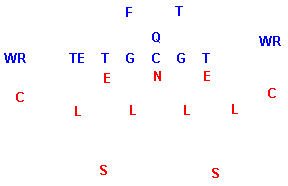 ideal
against the run due to only 3 down linemen, this defense offers an extra
defensive back for pass coverage. Consisting of a nose guard and
two other down linemen, the coach has the task of deciding who the outside
two linemen are--DEs or DTs. Often one of the LBs has zone pass coverage
responsibilities in effect employing 5 defensive backs. This is why
the 3-4 is often referred to as the "nickel" defense. Having 5 DBs
allows for random blitzing by one or more of these backs in order to maintain
a sufficient pass rush. The 3-4 is susceptible to the inside run
and is used primarily is situations where an interior run is not expected.
ideal
against the run due to only 3 down linemen, this defense offers an extra
defensive back for pass coverage. Consisting of a nose guard and
two other down linemen, the coach has the task of deciding who the outside
two linemen are--DEs or DTs. Often one of the LBs has zone pass coverage
responsibilities in effect employing 5 defensive backs. This is why
the 3-4 is often referred to as the "nickel" defense. Having 5 DBs
allows for random blitzing by one or more of these backs in order to maintain
a sufficient pass rush. The 3-4 is susceptible to the inside run
and is used primarily is situations where an interior run is not expected.
The 3-5 Defensive Formation
The 3-5 Defense, sometimes labeled the "prevent
defense" is a much maligned formation. Critics often say that the
only thing it prevents is winning. In fact, it is its misuse rather
than its design that often leads to failure. Similar in design to
the 3-4, the 3-5 (or the "dime" package) is an aggressive anti pass defense
utilizing multiple defensive backs. Recommended are the three down
linemen (NG and two DEs), two interior LBs, and six defensive backs.
Obviously, six defensive backs and only three down linemen is not going
to be particularly effective against the run. However, it is a formidable
pass defense. Intended for specific applications and limited uses,
repeated use of the defense does, in fact, allow steady movement of the
offense especially if the offense is willing to run inside and throw short.
Designed solely to stop the quick strike, deep pass patterns, and if used
sparingly, the 3-5 is a valuable asset to any team. A diagram is
not given due to the fact there are so many ways to situate six defensive
backs. The main concept should nevertheless remain apparent.
The 6-2 Defensive Formation
--a.k.a. 6-4 (with
tight DBs)
The 6-2 is the standard short yardage defensive
formation. It is often implemented to stop the run. Basically,
the six down linemen are positioned in the gaps between the offensive linemen
with the two inside linebackers playing run first, pass second. The cornerbacks
and the safety (playing up tight to the line) play pass first, run second,
each with deep third responsibilities.
The Goal Line Defensive Formation
(6-5)
The Goal Line Defense is similar in appearance to
the 6-2, but the responsibilities are different due to the proximity to
the goal line. There is no tomorrow at the goal line. No need
to worry about deep coverages or even medium ones. The middle two
linebackers stay back in order to meet the running back as he comes to
the line, particularly if the back leaves his feet and dives for the end
zone. The outer two linebackers (or CBs) have the luxury of playing
run first with containment responsibilities, leaving all six down linemen
free to penetrate and drive into the offensive back field. If the
offense passes the ball, the middle two linebackers (who remained back)
fall back to the end zone in zone pass coverage occupying the middle, while
the outside two linebackers retreat to cover the corners of the end zone.
The Safety reads the quarterback's eyes and plays the ball.



 defensive
ends, it is intended mainly as a run defense. However, it can be
effective against the pass as well with five pass rushers and two or three
linebackers. Usually, the down linemen's first responsibilities are
running lane specific, each man responsible for a certain gap or lane.
The default command for linemen is to read and react to the play, with
the defensive end's primary concern being containment. Occasionally,
a defensive end may be called on to pass defend an area such as the flat.
By design, the line backer's first responsibility is to defend the run,
then the pass. But this may be modified for varying purposes.
A coach wants his leading tacklers to be down linemen or line backers.
If a defensive back or safety is leading the team in tackles, it is a clear
indication that the opposing offenses are getting throughout the first
line of defense. The remaining four positions are the two corner
backs and the two safeties. An option is to allow one of the safeties
to be a "free safety" meaning that this player seldom has specific duties,
and is left to read and react to each play. If in zone pass coverage,
the free safety or safety to the TE side has "up" responsibility, while
the strong safety has deep third duty. Each corner has deep third
duty as well. LBs are 4 to 5 yards off the ball, CBs 3 to 6 yards
deep, safeties 10 to 12 yards. Down linemen keep the ball in the
corner of the eye, and move on the snap--not the QB's vocalizations or
other personnel movement.
defensive
ends, it is intended mainly as a run defense. However, it can be
effective against the pass as well with five pass rushers and two or three
linebackers. Usually, the down linemen's first responsibilities are
running lane specific, each man responsible for a certain gap or lane.
The default command for linemen is to read and react to the play, with
the defensive end's primary concern being containment. Occasionally,
a defensive end may be called on to pass defend an area such as the flat.
By design, the line backer's first responsibility is to defend the run,
then the pass. But this may be modified for varying purposes.
A coach wants his leading tacklers to be down linemen or line backers.
If a defensive back or safety is leading the team in tackles, it is a clear
indication that the opposing offenses are getting throughout the first
line of defense. The remaining four positions are the two corner
backs and the two safeties. An option is to allow one of the safeties
to be a "free safety" meaning that this player seldom has specific duties,
and is left to read and react to each play. If in zone pass coverage,
the free safety or safety to the TE side has "up" responsibility, while
the strong safety has deep third duty. Each corner has deep third
duty as well. LBs are 4 to 5 yards off the ball, CBs 3 to 6 yards
deep, safeties 10 to 12 yards. Down linemen keep the ball in the
corner of the eye, and move on the snap--not the QB's vocalizations or
other personnel movement.
 the
5-3 simply replaces the free safety spot with a third line backer which
lines up on the outside shoulder of the TE, 5 yards deep and parallel with
the other LBs. The "best" LB move to the middles LB position.
Obviously, modifications, or shifts, may be necessary depending on the
actual alignment of the offense. For example, let's say the offense
opened in a Tripps (3 receiver) set to the defense's right. basically,
all that has happened is the FB and left wide out have been replaced with
two new wide outs to the right. So the left CB shifts over with the
new WR, and the left OLB shifts over as well. The two remaining linebackers
return to their normal 5-2 alignment. Another variation calls for
the 3 line backers to all shift down to compensate. The TE can be
covered by the DE to that side, or the LB to that side. The DE to
the Tripps side can cover the flat or slat area, or even be sent on a blitz.
the
5-3 simply replaces the free safety spot with a third line backer which
lines up on the outside shoulder of the TE, 5 yards deep and parallel with
the other LBs. The "best" LB move to the middles LB position.
Obviously, modifications, or shifts, may be necessary depending on the
actual alignment of the offense. For example, let's say the offense
opened in a Tripps (3 receiver) set to the defense's right. basically,
all that has happened is the FB and left wide out have been replaced with
two new wide outs to the right. So the left CB shifts over with the
new WR, and the left OLB shifts over as well. The two remaining linebackers
return to their normal 5-2 alignment. Another variation calls for
the 3 line backers to all shift down to compensate. The TE can be
covered by the DE to that side, or the LB to that side. The DE to
the Tripps side can cover the flat or slat area, or even be sent on a blitz.
 The 4-4 uses four down linemen, four linebackers, two cornerbacks, and
a safety. Stunts are a common component of this defensive set, usually
with the some or all of the linemen stunting left or right and the inside
linebackers stunting in the opposite direction. A wide range of possible
stunts and blitzes are possible. The 4-4, also known as the "Stack"
defense, relies on quickness, particularly quickness in pursuit.
In order to run the 4-4 on a regular basis, the interior down linemen must
be players of considerable substance.
The 4-4 uses four down linemen, four linebackers, two cornerbacks, and
a safety. Stunts are a common component of this defensive set, usually
with the some or all of the linemen stunting left or right and the inside
linebackers stunting in the opposite direction. A wide range of possible
stunts and blitzes are possible. The 4-4, also known as the "Stack"
defense, relies on quickness, particularly quickness in pursuit.
In order to run the 4-4 on a regular basis, the interior down linemen must
be players of considerable substance.
 and
quickness necessary to run the 4-3 defense, it is a formidable defensive
formation. Besides the ever present four down linemen (2 DTs and
2 DEs), there are three line backers--two to the inside and one at the
outside shoulder of the TE. Two cornerbacks and two safeties are
the standard. Equally effective against most all offensive formations,
the 4-3 is the default defense of choice for this author. It is easily
modified for various offensive sets. The third LB (on the TE) can cover
the TE, blitz, or cover any of the short zones to that side or the hook
zone over the middle. The CBs can blitz with the Safety(s) assuming
the Corner's responsibilities. Or a Corner can drop back in deep
coverage allowing a safety blitz. Because of its high flexibility,
an offense will find it difficult to isolate a particular area or defensive
player. If the 4-3 has a weakness, it is that the inside line backers
are the primary tacklers for runs between the tackles and they are of course
4 to 5 yards off the ball.
and
quickness necessary to run the 4-3 defense, it is a formidable defensive
formation. Besides the ever present four down linemen (2 DTs and
2 DEs), there are three line backers--two to the inside and one at the
outside shoulder of the TE. Two cornerbacks and two safeties are
the standard. Equally effective against most all offensive formations,
the 4-3 is the default defense of choice for this author. It is easily
modified for various offensive sets. The third LB (on the TE) can cover
the TE, blitz, or cover any of the short zones to that side or the hook
zone over the middle. The CBs can blitz with the Safety(s) assuming
the Corner's responsibilities. Or a Corner can drop back in deep
coverage allowing a safety blitz. Because of its high flexibility,
an offense will find it difficult to isolate a particular area or defensive
player. If the 4-3 has a weakness, it is that the inside line backers
are the primary tacklers for runs between the tackles and they are of course
4 to 5 yards off the ball.
 ideal
against the run due to only 3 down linemen, this defense offers an extra
defensive back for pass coverage. Consisting of a nose guard and
two other down linemen, the coach has the task of deciding who the outside
two linemen are--DEs or DTs. Often one of the LBs has zone pass coverage
responsibilities in effect employing 5 defensive backs. This is why
the 3-4 is often referred to as the "nickel" defense. Having 5 DBs
allows for random blitzing by one or more of these backs in order to maintain
a sufficient pass rush. The 3-4 is susceptible to the inside run
and is used primarily is situations where an interior run is not expected.
ideal
against the run due to only 3 down linemen, this defense offers an extra
defensive back for pass coverage. Consisting of a nose guard and
two other down linemen, the coach has the task of deciding who the outside
two linemen are--DEs or DTs. Often one of the LBs has zone pass coverage
responsibilities in effect employing 5 defensive backs. This is why
the 3-4 is often referred to as the "nickel" defense. Having 5 DBs
allows for random blitzing by one or more of these backs in order to maintain
a sufficient pass rush. The 3-4 is susceptible to the inside run
and is used primarily is situations where an interior run is not expected.